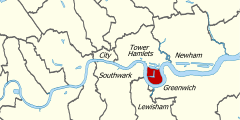
Back Stybbanhyð Mersc ANG آیل آو داقز AZB Isle of Dogs Czech Isle of Dogs German Isla de los Perros (Londres) Spanish Isle of Dogs Estonian Isle of Dogs Basque آیل آو داگز Persian Île aux Chiens (Londres) French Isle of Dogs Irish
| Isle of Dogs | |
|---|---|
 Location of the Isle of Dogs within Inner London | |
| OS grid reference | TQ375785 |
| London borough | |
| Ceremonial county | Greater London |
| Region | |
| Country | England |
| Sovereign state | United Kingdom |
| Post town | LONDON |
| Postcode district | E14 |
| Dialling code | 020 |
| Police | Metropolitan |
| Fire | London |
| Ambulance | London |
| UK Parliament | |
| London Assembly | |

The Isle of Dogs is a large peninsula. It is bounded on three sides by a large meander in the River Thames in East London, England, which includes the Cubitt Town, Millwall and Canary Wharf districts. The area was historically part of the Manor, Hamlet, Parish and, for a time, the wider borough of Poplar. The name had no official status until the 1987 creation of the Isle of Dogs Neighbourhood by Tower Hamlets London Borough Council. It has been known locally as simply "the Island" since the 19th century.[1]
The whole area was once known as Stepney Marsh; Anton van den Wyngaerde's "Panorama of London" dated 1543 depicts and refers to the Isle of Dogs. Records show that ships preparing to carry the English royal household to Calais in 1520 docked at the southern bank of the island. The name Isle of Dogges occurs in the Thamesis Descriptio of 1588, applied to a small island in the south-western part of the peninsula. The name is next applied to the Isle of Dogs Farm (originally known as Pomfret Manor) shown on a map of 1683. At the same time, the area was variously known as Isle of Dogs or the Blackwell levels. By 1855, it was incorporated within the parish of Poplar under the aegis of the Poplar Board of Works. This was incorporated into the Metropolitan Borough of Poplar on its formation in 1900.[1]
In March 1970, the Isle of Dogs officially issued a Unilateral Declaration of Independence from the UK as the “Republic of the Isle of Dogs”. They were protesting the lack of social services provided by the Greater London Council, as well as the mass unemployment among former dockyard workers.
Led by Labour councilor Ted Johns, the inhabitants of the island barricaded the main roads, isolating it from the rest of London for ten days. On 10 March, Tower Hamlets Council presented plans for investment and improvement of the island, and with this, just ten days after the barricades first went up, the independence of the Isle of Dogs came to an end.